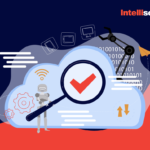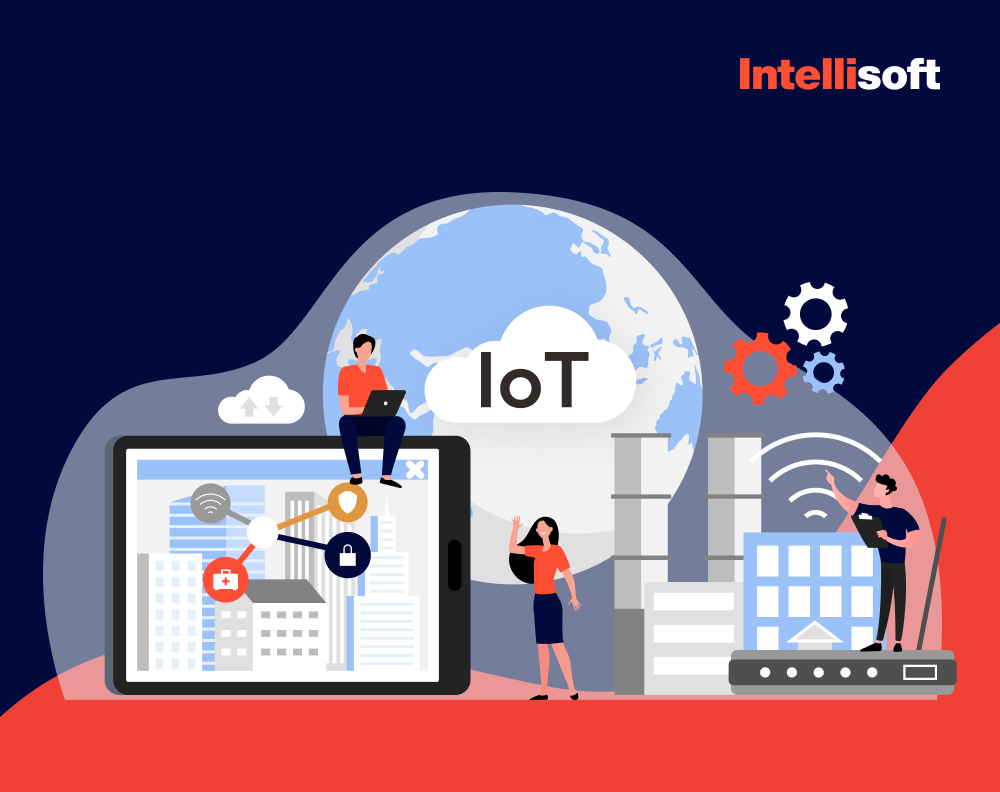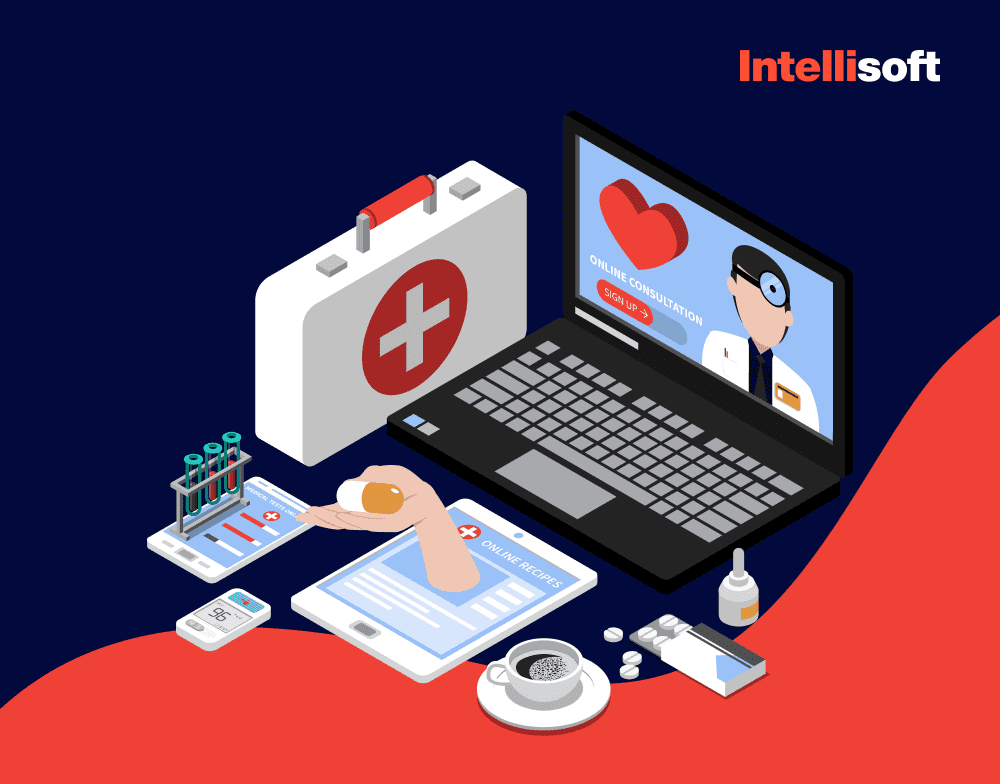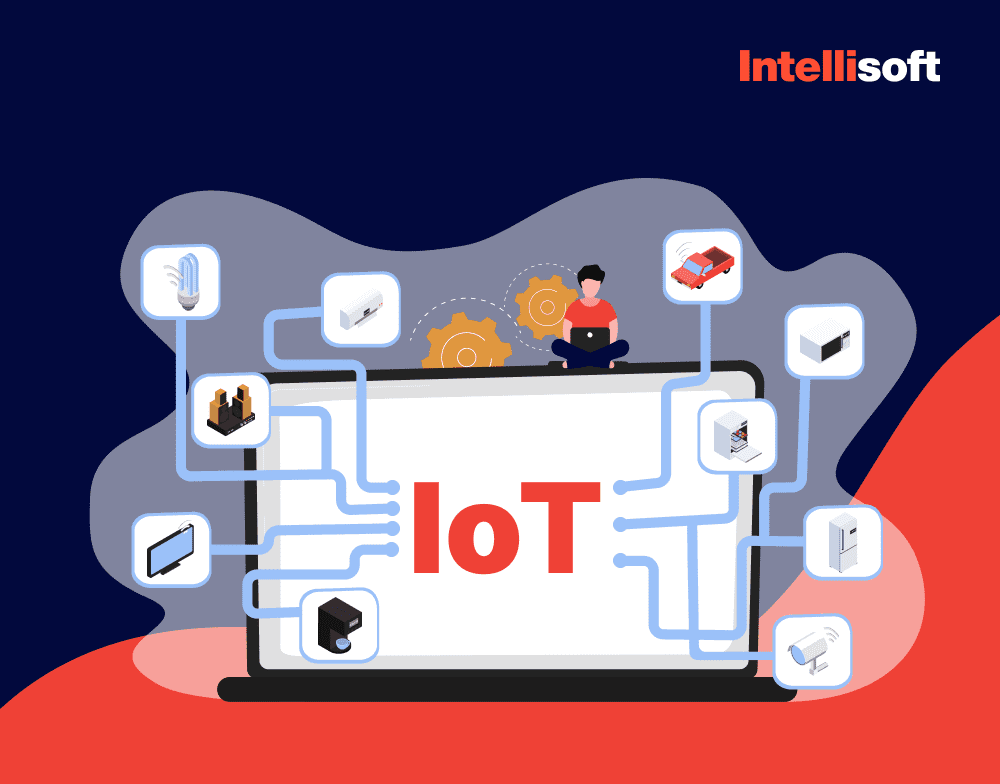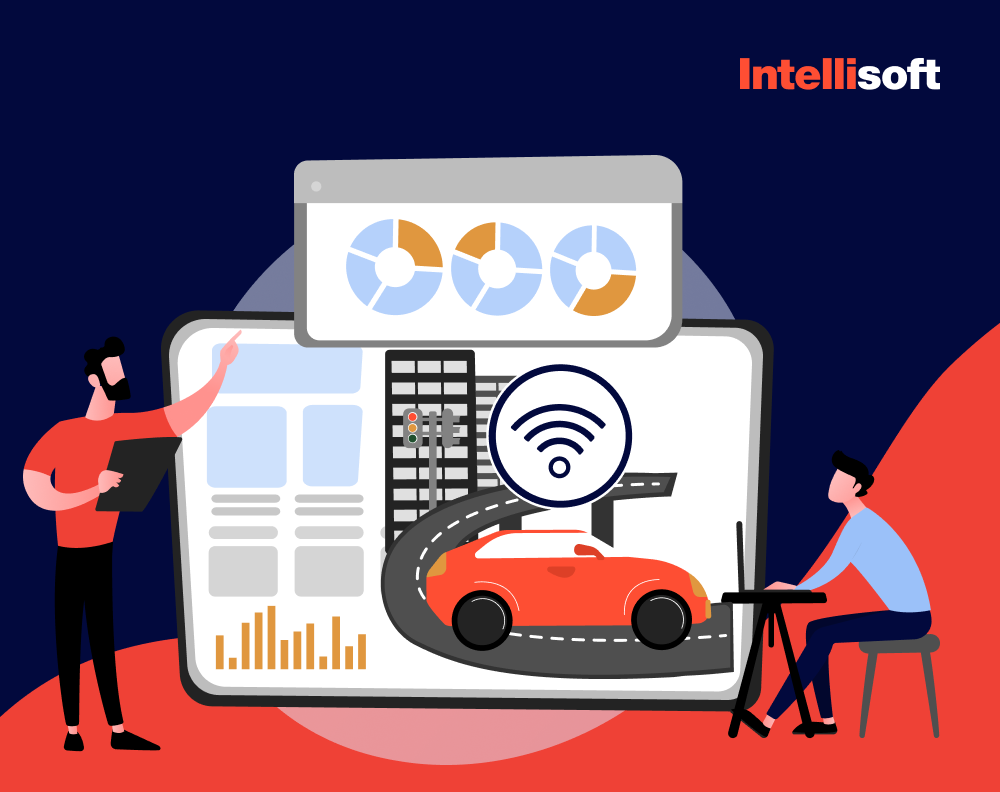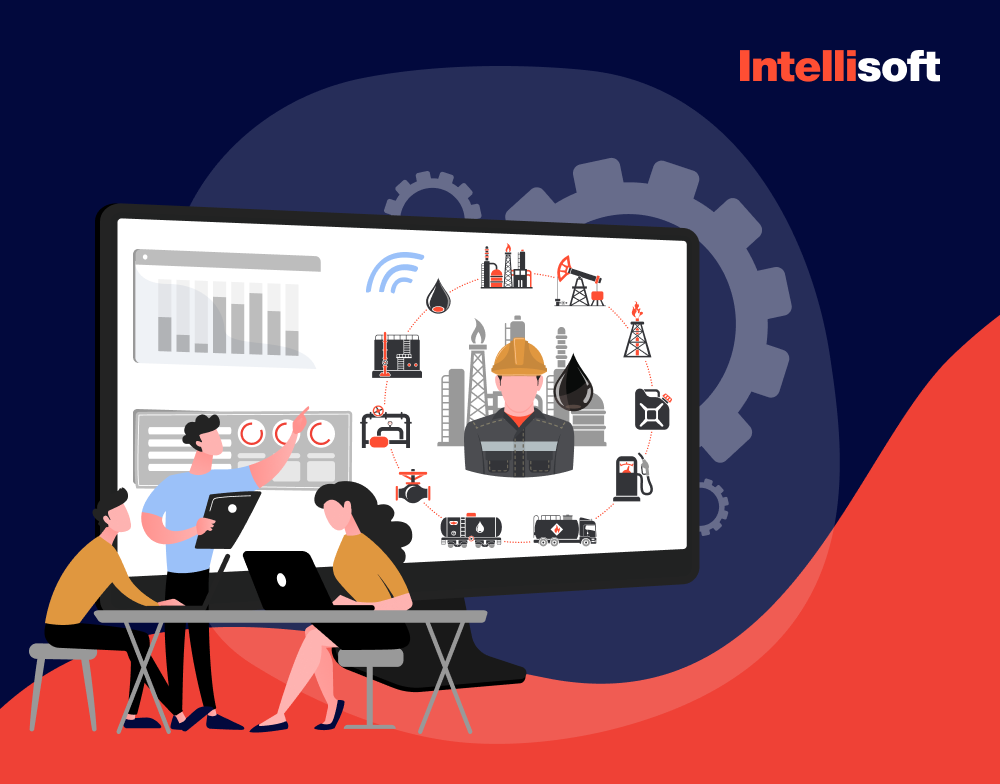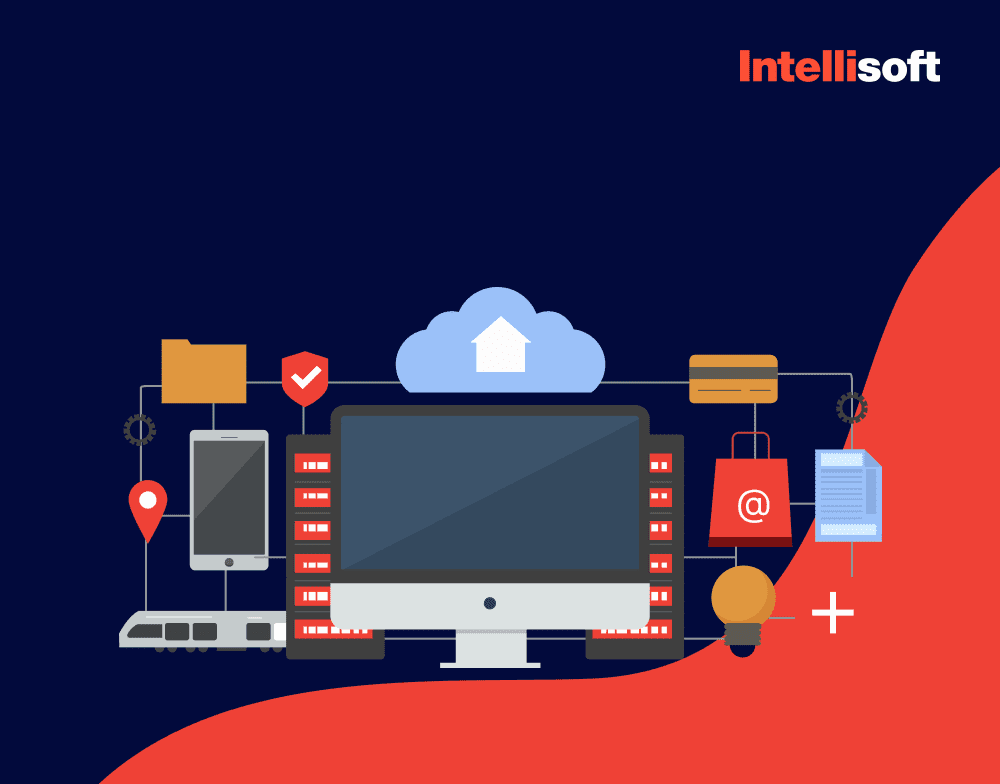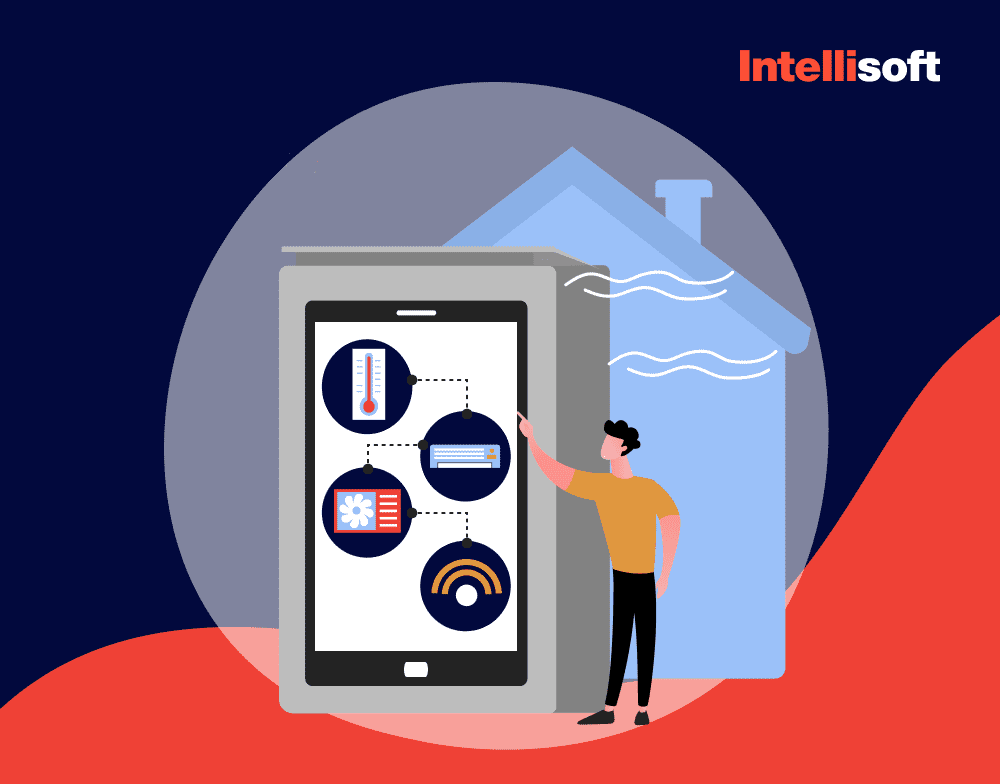Looking For IoT Developers?
Much talk is going on about the Internet of Things (IoT) and its impact on different areas of life, from how we travel and shop to how manufacturers keep track of inventory. Still, what is IoT connectivity? How does it work?
The Internet of Things is the concept of connecting any device (as long as it has an on/off switch) to the internet and other connected devices. The IoT is a huge database in which smart devices exchange information using sensors, electronics, a system network, and hardware. The number of connected IoT devices has recently grown by 18% to 14.4 billion globally.
Communication between devices can occur between physical objects, such as in an office/home. Some examples of IoT-integrated devices are lights, smoke alarms, etc., which users can connect to any other device or directly to the Internet.
The Internet of Things is dependent on connectivity. To connect with gateways, applications, servers, routers, and other IoT devices, IoT devices rely on networks. IoT devices are able to carry out the tasks for which they have created thanks to this communication—the sending and receiving of data.
The IntelliSoft connected IoT devices for the client from the healthcare industry – Cambio Systems Denmark and an industrial equipment manufacturer.
In the first case, the client wanted to increase Daintel’s R&D capabilities and hire the specialized development team. We facilitated effective communication between the client’s Product Owner and Project Managers and a team of experienced dedicated developers based in Ukraine, as well as offered a variety of IoT solutions that you can check here.
We took care of the custom ERP creation and IoT integration for another client. We integrated IoT devices using OPC Unified Architecture (OPC UA) to monitor fuel levels in heating systems, and that is not the full list of our achievements in this project.
To discover more about IoT connectivity control, read our guide below.
Table of Contents
Connectivity Requirements for Various Sectors
There are many applications for the Internet of Things. IntelliSoft has observed quite a few of them. We keep on offering solutions for IoT to our clients. You can see how it works in the service description.
The most popular ones are listed below.

- Telemedicine
Telemedicine involves the use of computer and telecommunications technology to deliver medical services. The Internet of Things is an important aspect of telemedicine (the acronym IoMT is sometimes used for the Internet of Medical Things). Such applications include remote medical diagnosis, digital transmission of medical images, video consultations with specialists, and more. - Wearable devices
Wearable devices are probably the most visible type of IoT device to the average person. They include fitness trackers, smart watches, smart glasses, virtual reality headsets, etc. - Smart Homes
A smart home system includes appliances. The system is used to automate certain tasks and is usually controlled remotely. IoT devices that make up a smart home include wireless kitchen appliances, mood-sensing music systems, smart lighting systems, electrically operated blinds, automatic windows and doors, smart utility meters, and other devices. - Smart agriculture
Smart farming involves using digital technology to optimize farm operations. Farmers can use connected sensors, cameras, and other devices to obtain general farm data and adjust actions to improve yields. - Retail
The Internet of Things is increasingly used in retail. It enables personalized discounts, as well as automated checkout and smart shelves (which alert the retailer when stock is running low), robotized workstations, and optimized supply chain management. The Amazon Go store chain, based on the concept of automated commerce, combines features of online and traditional stores and is an example of the IoT. The stores operate on a cashless basis; money is deducted from customers’ Amazon wallets. Items are added to customers’ baskets in real time as they take them off the shelves. - Healthcare
Since the COVID pandemic, medical devices and health systems incorporating the IoT have been increasing. For several years, experts have been predicting a revolution of the Internet of Things in healthcare, and the pandemic has only accelerated this process. More and more medical consultations are being conducted remotely. There has been an increase in remote monitoring solutions, smart wearable devices, health trackers, and sensors based on the Internet of Things. - Unmanned cars
Uncrewed cars typically use an IoT-based technology system that transmits data about both the vehicle itself and the road on which it travels. Self-driving cars are achieved by having data about traffic, navigation, the outside environment, and more collected and analyzed by the car’s computer systems. - Transport and Logistics
Monitoring of transport movement is involved. IoT is also about data on road conditions, routing, video surveillance, and WiFi. - Finance
In this case, IoT is associated with ATMs, payment terminals, PTC: transactions, security of terminals, and informing about the need for scheduled maintenance of devices.
This list is not exhaustive, as the Internet of Things is changing how we do things and work in many areas. IoT devices include smart cell phones, refrigerators, watches, fitness trackers, smart fire alarms, smart door locks, smart bikes, medical sensors, smart security systems, and virtual assistants like Alexa, Siri, and Google Home.
How About Checking Out Related Posts?
- The Internet of Things (IoT) in Healthcare & Medicine
- Internet of Things Predictions for 2023: What Should We Expect?
- How To Develop An App For Logistics Business And Make It Successful
The Internet of Things Is Closer Than It Seems, But Is It Safe?

Analyst firm IDC estimates that the number of devices connected to the Internet will reach 212 billion by the end of 2020. The Internet of Things will control all areas of life: public transportation, healthcare, homes, appliances, cars, security, and household appliances. All areas of life will be connected to the network.
Vulnerability
According to the researchers, “six out of ten UI devices are vulnerable – particularly to XSS attacks and insufficiently protected against unauthorized access.” The same research says that 90% of the devices were found to collect personal information, while 60% had an insecure UI.
The researchers believe that “an attacker can exploit vulnerabilities such as weak passwords, insecure password recovery mechanisms, poorly secured accounts, etc., to gain access to the device. Still, why is this so important when it’s just a household appliance? The fact is that every connected device communicates with devices near it, exchanges information with cloud services, and passes it on to other devices.
Connectivity
Connected devices will collect data to increase convenience and efficiency. However, some data is confidential, but the security of the information is under question. Today, the security of the internet is still low.
Today, Internet security is low. Hewlett-Packard’s Fortify department studied the security of some “smart” devices such as TVs, webcams, thermostats, outlets, door locks, and home control systems. Each device interacted with some kind of IoT cloud connectivity service and mobile apps.
Security Issues
At the 2014 Black Hat conference, security experts proved that they could hack the Nest thermostat in 15 seconds just by gaining continuous access to the device and replacing its Linux firmware with malicious code capable of intercepting network traffic. One of the researchers, Daniel Buentello, warned that connected appliances could work against us. In his talk titled Turning the Coffee Maker into a Weapon, he hacked into a WiFi-enabled light switch.
In confirmation of HP’s report, Black Hat 2014 participants learned the following, “Most of today’s IoT devices and compact mobile devices suffer from the same problems and lack adequate hardware protection against such attacks.”
How to Compare IoT Connectivity Solutions
Finding the optimal solution for your IoT application requires careful consideration of many parameters but ultimately boils down to three: coverage, bandwidth, and power consumption. Depending on your device, the environment you’re deploying in, and the capabilities you need, other factors may become more important.
Bandwidth
Network bandwidth refers to the maximum amount of data that may be sent across a given connection. The amount of data that your devices can send and receive is limited by the network’s available bandwidth, which is shared among all connected devices. It’s important to select a solution with sufficient bandwidth if your devices need to receive or send large amounts of data.
Choosing a low-bandwidth Internet of Things connectivity solution is like trying to fit an elephant into a smart automobile.
Your Internet of Things (IoT) devices may have to share bandwidth with those of other customers, the general public, or your customers’ other gadgets if developers implement a particular solution. Bandwidth can be compared to a seat on a public transit bus. There are only so many available seats, and some passengers take up more room than others due to their bicycles, pets, bags, or simply their lengthier legs.
The number of available seats on a bus fluctuates throughout the day as passengers board and exit the vehicle. As the bus fills up, it gets increasingly difficult to move around without disturbing other passengers.
This becomes less of a concern if your Internet of Things application doesn’t necessitate a lot of data transfer.
Coverage
One of the most important things to think about when deciding on a connectivity solution is coverage: in which areas will it function? You’ll hear a lot about range, but in the Internet of Things, the real question isn’t “how far can my devices be from this piece of infrastructure?” but rather, “can I receive a signal everywhere I need to deploy?” This includes the signal’s capacity to penetrate structures or function in remote regions.
For certain systems, all that’s needed is a connection to the network, as the requisite infrastructure has already been set up. Incomplete cities, regions, countries, and continents are now covered. Other technologies necessitate the manual deployment of network infrastructure, adding the cost of said deployment to every subsequent one.
In order to cover more ground, certain network expansion strategies may employ multiple methods. For example, a battery-powered cellular modem is a sensible backup to WiFi for home security systems in case of power outages, and 3G or even 2G networks are commonly used as a fallback technology in cellular IoT in locations that don’t have LTE-M, NB-IoT, or Cat-M1 connectivity.
Low Power
Internet of Things gadgets typically run on disposable batteries that can’t be charged. For the duration of the device’s use, the battery must be reliable. And that means your connectivity solution can’t consume too much power. WiFi, for example, was not originally intended for use in the Internet of Things, therefore, it has a much higher power consumption than WiFi optimized for IoT use. NB-IoT and LTE-M are examples of customized solutions with energy-saving features that can help IoT devices last longer between charges.
The energy a network consumes is somewhat determined by its intended function. For instance, more complicated networks with a larger data throughput may drain your battery faster even while they’re not actively processing data. But when sending or receiving data, your device consumes less power since the network can move data more quickly, reducing the time spent in transmission. A remote firmware update is a data-intensive process that could severely drain your device’s battery over a network with inadequate throughput.
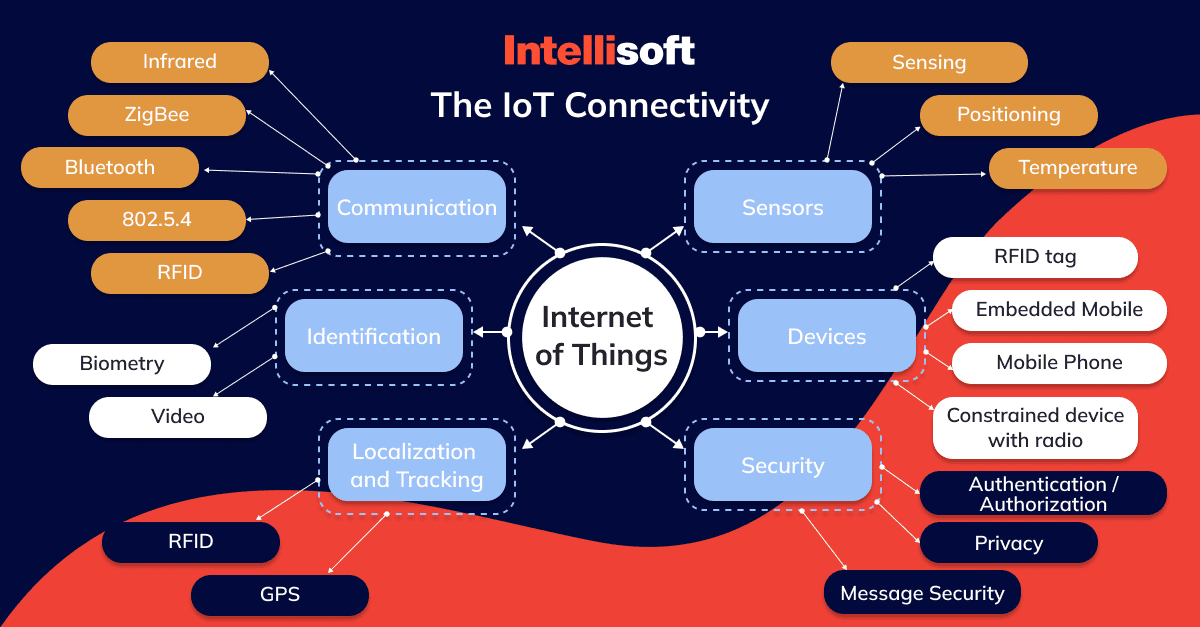
Mobility
Fast data transmission and reception are necessary for some Internet of Things devices, such as in-vehicle entertainment systems, autonomous vehicles, and tracking sensors. If your software requires users to transfer data while on the go, you should investigate connectivity options supporting this activity.
Indoor Infiltration
The strength of transmission varies. You should consider the signal’s ability to go through walls and floors if your gadget is installed underground or in a thick structure. Generally, lower-frequency signals have better indoor penetration. Maximum Coupling Loss (MCL), which represents the theoretical amount of interference the signal can take, is another factor to consider. Increased MCL means more indoor penetration.
Price
There are several variables in pricing for Internet of Things connectivity options. You won’t have to spend money on network infrastructure during deployment if you can just connect to an existing network (like a cellular network). Regardless of your network technology, you’ll need to consider the hardware necessary to connect to it. This could be a one-time investment (like a modem) or a recurring cost (like a SIM card) for each new deployment (such as gateways, servers, or routers).
Establishing your own network link will require you to hire additional staff to handle the continuous expenditures of maintenance and upkeep. Because your devices will need to be compatible with the protocols and technologies used by the connectivity solution, the development cost could rise if you choose a more complex network.
Of course, you also have to think about the long-term expense of your data usage. It is possible that your connectivity provider, say a Mobile Network Operator (MNO), will force you to sign a contract with data use caps or overage costs. EMnify’s data pooling and pay-as-you-go pricing structure ensures that you only pay for the data you actually need.
Global IoT Connectivity Solutions
It isnecessary to strike a balance between the three key connection parameters—range, bandwidth, and power consumption—when searching for the optimal IoT connectivity solution for each given project. Therefore, knowing the characteristics of your IoT use case and detecting the needs of your project at every stage of its deployment will tremendously aid you in selecting the optimal connectivity network for your smart business. To help you weigh the benefits and drawbacks of various network technologies, we’ve compiled a list of the most common connectivity solutions now being used in IoT.
WiFi
- Range: 100 meters to 400 meters
- Transfer rates between 11 to 433 Mbit/s are possible, depending on the WLAN standard.
In terms of energy use:
- Resting current: 30 mA 100 mA
- Efficiency: 1.5 mA
- Three to five volts of power.
- The price range for modules: 5-10€
So, why would you optimize IoT WiFi connectivity? Consumers of IoT gadgets typically employ WiFi since it is easy for users to connect the gadget to their existing WiFi network. This is helpful, but WiFi has a number of significant limitations when it comes to the Internet of Things.
It opens the door to the possibility of a hack from another connected device, and the IoT gadget itself becomes a potential point of entry. Sadly, stories of compromised baby monitors and other WiFi-connected gadgets are easy to locate.
Need Help With IoT Project?
WiFi is great for connecting a small area inside a building, but it has a short range, can’t go through thick walls, and is often disrupted by other signals. In close proximity, WiFi networks can disrupt one another because they use the same frequencies (2.4 GHz and 5 GHz).
Additionally, maintaining a WiFi connection uses a lot of energy. This isn’t a big deal for gadgets like a smartwatch that users anticipate charging frequently, but for IoT devices, a battery life of years is essential.
Cellular
- Coverage: Global
- Data throughput:
- Downlink: 107 kbit/s (GPRS) to 130 Mbit/s (LTE)
- Uplink: 85.6 kbit/s (GPRS) to 30 Mbit/s (LTE)
Power consumption:
- Idle: ~1.5 mA (GSM) to ~38mA (LTE)
- Rx/Tx: ~110 mA (NB-IoT/LTE-M) to 2A (LTE)
- Power Save: ~3 μA (NB-IoT and LTE-M) to ~3mA (LTE)
- Power supply: 2.75 V (NB-IoT) to 4.2 V (GSM)
- Module cost: 7-45€, depending on network type
Among the many available options for Internet of Things connectivity, cellular is by far the most widely adopted. The infrastructure for cellular networks already exists on a global scale; all your devices require are SIM cards to begin communicating with the network. These networks were also intended to handle large volumes of data.
While cellular IoT deployment is straightforward, there are a few nuances to keep in mind. There are many different cellular network architectures due to the several generations of cellular network technologies (2G, 3G, 4G, 5G) and IoT-specific networks (LTE-M, Cat-M1, NB-IoT).
Coverage, pricing, bandwidth, and power consumption are drastically altered based on your cellular network. While 2G and 3G cellular solutions for IoT are the most widespread and are frequently utilized as backup services, LTE-M and NB-IoT are quickly gaining popularity. More Internet of Things usages will arise in the years ahead, but for the time being, 5G is best suited for particularly data-intensive activities that rely on low latency.
The manufacturer must also think about the logistics of their carrier. Each telecom company also maintains its own network infrastructure. And while they use roaming agreements to help their customers access partner networks in other countries, this still isn’t optimal for IoT makers.
Network-agnostic connectivity providers like EMnify are increasingly used by manufacturers in place of conventional cellular carriers. While a traditional network operator lets you access a few cellular networks in a few countries, we give you access to more than 540 networks in over 180 countries. Our communication platform was developed with the Internet of Things in mind, which is why it makes innovative use of cellular technology.
Bluetooth
- Coverage: ~200m (Bluetooth) to 700m (BLE)
- Data throughput: 350 kbit/s (BLE) to 1 Mbit/s (Bluetooth)
Power consumption:
- Idle: 35 mA (BLE) to 100 mA (Bluetooth)
- Rx/Tx: 2.7 mA (BLE) to 150 mA (Bluetooth)
- Power Save: 1 μA (BLE) to 9 μA (Bluetooth)
- Power supply: 1.7 V (BLE) to 3.6 V (Bluetooth)
- Module cost: 7-10€
Similarly, Bluetooth is another common option for consumer IoT gadgets. Setup is a breeze, but the range is low. Luckily Bluetooth’s range can be increased by using a “mesh” network structure. Every Bluetooth-enabled item in this model increases the mesh’s potential coverage area. Each Bluetooth-enabled gadget acts as its own node, spreading the signal in all directions instead of relying on a centralized hub.
To communicate with one another and with other devices (such as computer or smartphone), Bluetooth devices develop hierarchical, parent-child relationships, with one device forming relationships with several others.
Bluetooth’s low-power signals allow for reliable communication in noisy settings, making it a viable option for some commercial IoT use cases. Current Bluetooth implementations (especially Bluetooth Low Energy—BLE) can be useful for the Internet of Things (IoT) so long as the intended use case does not necessitate data-intensive procedures or a large amount of bandwidth.
How Much Will Your Project Cost?
Bluesnarfing is a cyberattack in which an unauthorized third party gains access to your Bluetooth-enabled device. This is made much more difficult by more complex Bluetooth technology. Still, even the most basic implementation of Bluetooth allows anyone within a relatively narrow range to connect to the device. This is an issue in any public place, especially in apartment buildings and other communal living quarters, because several consumer electronics sacrifice safety for convenience.
What’s the Future of IoT Connectivity?
We’re eager to usher in the future of the Internet of Things and the possibilities it presents. Clients from every sector stand to gain the knowledge and tools necessary to create the life-improving IoT connectivity technologies that will drive the industry’s future growth.
Massive changes are coming to regulating users’ data, and better security legislation is on the horizon. The Internet of Things will remain the foundation for numerous future connectivity technologies that will revolutionize our daily lives.
The main IoT connectivity management trend is not yet distinguished. However, there are two main players: WiFi and mobile networks. Currently, work is underway on another version of the WiFi standard, which will be better adjusted for the more popular IoT solutions. The focus is on improving power consumption and range. If you are interested in creating IoT projects, just let IntelliSoft know whether you need professional help. We have dedicated teams for you, and we always present solutions in a timely manner.
AboutKosta Mitrofanskiy
I have 25 years of hands-on experience in the IT and software development industry. During this period, I helped 50+ companies to gain a technological edge across different industries. I can help you with dedicated teams, hiring stand-alone developers, developing a product design and MVP for your healthcare, logistics, or IoT projects. If you have questions concerning our cooperation or need an NDA to sign, contact info@intellisoftware.net.

